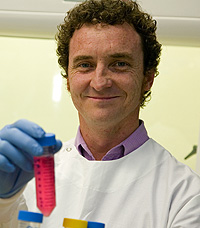Home > Press > UQ gets fabrication infrastructure boost
 |
| Professor Cooper-White |
Abstract:
A $100 million Australian National Fabrication Facility launched this month in Canberra includes a Queensland node, based at The University of Queensland.
UQ gets fabrication infrastructure boost
Australia | Posted on October 21st, 2008The ANFF links seven university-based centres around the country, giving researchers and industry access to state-of-the-art fabrication facilities.
It was established last year under the National Collaborative Research Infrastructure Strategy, and will enable researchers to engineer and manipulate materials down to the scale of billionths of a metre.
The Minister for Innovation, Industry, Science and Research, Senator Kim Carr said the new facility represented a major step forward in Australia's capacity for research in nanotechnology and micro-fabrication.
UQ Deputy Vice-Chancellor (Research) Professor David Siddle welcomed the announcement.
"The development of facilities to support research is essential to Australia's future international competitiveness," he said.
"As a leading research-intensive university, UQ is playing a significant role in the development of national research infrastructure."
Professor Siddle said it was in the national interest for leading research institutions to collaborate on the development of world-class facilities.
The Queensland node has received $12 million support, including $10 million Federal and State Government funding, with the balance from UQ.
Professor Justin Cooper-White, of UQ's Australian Institute for Bioengineering and Nanotechnology, is Director of the Queensland node.
"The facility is more than a collection of leading-edge equipment and specialist clean rooms minimising unwanted particulate contamination; it is managed and staffed by key senior research officers with extensive expertise," he said.
"It provides a dedicated facility for the synthesis, processing, characterisation and fabrication of functional organics and organic semiconductors, new generation photoresists, functional polymers and nanoparticles and bio-inspired nanomaterials, smart surfaces and microdevices."
The Queensland node consists of two facilities, the Soft Materials Processing Facility and the BioNano Device Fabrication Facility.
They are based at UQ in purpose-built laboratories in the Australian Institute for Bioengineering and Nanotechnology and the School of Chemistry's Centre for Organic Photonics and Electronics
####
For more information, please click here
Contacts:
Jan King
telephone 07 3365 1120
Copyright © University of Queensland
If you have a comment, please Contact us.Issuers of news releases, not 7th Wave, Inc. or Nanotechnology Now, are solely responsible for the accuracy of the content.
| Related News Press |
News and information
![]() Researchers develop molecular qubits that communicate at telecom frequencies October 3rd, 2025
Researchers develop molecular qubits that communicate at telecom frequencies October 3rd, 2025
![]() Next-generation quantum communication October 3rd, 2025
Next-generation quantum communication October 3rd, 2025
![]() "Nanoreactor" cage uses visible light for catalytic and ultra-selective cross-cycloadditions October 3rd, 2025
"Nanoreactor" cage uses visible light for catalytic and ultra-selective cross-cycloadditions October 3rd, 2025
Govt.-Legislation/Regulation/Funding/Policy
![]() New imaging approach transforms study of bacterial biofilms August 8th, 2025
New imaging approach transforms study of bacterial biofilms August 8th, 2025
![]() Electrifying results shed light on graphene foam as a potential material for lab grown cartilage June 6th, 2025
Electrifying results shed light on graphene foam as a potential material for lab grown cartilage June 6th, 2025
![]() Institute for Nanoscience hosts annual proposal planning meeting May 16th, 2025
Institute for Nanoscience hosts annual proposal planning meeting May 16th, 2025
Academic/Education
![]() Rice University launches Rice Synthetic Biology Institute to improve lives January 12th, 2024
Rice University launches Rice Synthetic Biology Institute to improve lives January 12th, 2024
![]() Multi-institution, $4.6 million NSF grant to fund nanotechnology training September 9th, 2022
Multi-institution, $4.6 million NSF grant to fund nanotechnology training September 9th, 2022
Chip Technology
![]() Lab to industry: InSe wafer-scale breakthrough for future electronics August 8th, 2025
Lab to industry: InSe wafer-scale breakthrough for future electronics August 8th, 2025
![]() A 1960s idea inspires NBI researchers to study hitherto inaccessible quantum states June 6th, 2025
A 1960s idea inspires NBI researchers to study hitherto inaccessible quantum states June 6th, 2025
![]() Programmable electron-induced color router array May 14th, 2025
Programmable electron-induced color router array May 14th, 2025
Announcements
![]() Rice membrane extracts lithium from brines with greater speed, less waste October 3rd, 2025
Rice membrane extracts lithium from brines with greater speed, less waste October 3rd, 2025
![]() Researchers develop molecular qubits that communicate at telecom frequencies October 3rd, 2025
Researchers develop molecular qubits that communicate at telecom frequencies October 3rd, 2025
![]() Next-generation quantum communication October 3rd, 2025
Next-generation quantum communication October 3rd, 2025
![]() "Nanoreactor" cage uses visible light for catalytic and ultra-selective cross-cycloadditions October 3rd, 2025
"Nanoreactor" cage uses visible light for catalytic and ultra-selective cross-cycloadditions October 3rd, 2025
|
|
||
|
|
||
| The latest news from around the world, FREE | ||
|
|
||
|
|
||
| Premium Products | ||
|
|
||
|
Only the news you want to read!
Learn More |
||
|
|
||
|
Full-service, expert consulting
Learn More |
||
|
|
||








